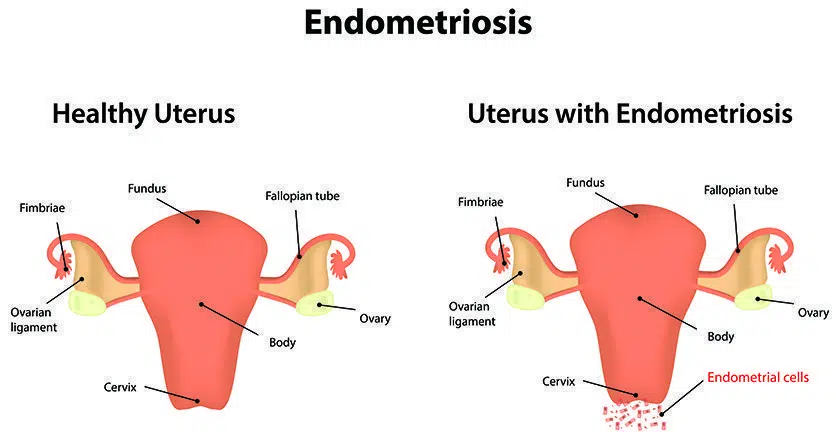Endometriosis is a condition where cells similar to the lining of the uterus, or endometrium, grow outside the uterus. This misplaced tissue will still respond to a woman’s monthly hormonal cycle, causing pain and discomfort. It is important for women to know, that some severe cases do not cause pain, while some lesser cases of Endometriosis may be very painful, so accurate diagnosis is essential regardless of the perception of pain. Left untreated, the effects of the disease can be physically and psychologically traumatizing.
Table of Contents
The link between Endometriosis and infertility is huge – 30% to 40% of women who have it are likely to have problems conceiving. Endometriosis causes conception difficulties that can include organ damage, low levels of specific molecules to promote fertilization, increased peritoneal white blood cells, and a malfunctioning immune system.
SYMPTOMS

- chronic menstrual cramps (dysmenorrhea) and ovulation
- bowel movement problems
- painful sexual intercourse
- back pain
- nausea
- headache
- fluid retention
In addition to fertility issues, women living with endometriosis also often experience lifestyle disruptions due to :
- Less resistant to immune disorders, such as fever, flu and asthma
- Side effects of short-term and long-term medication
- Reaction to hormone treatment
- Recurrent minor and major surgeries
CAUSES
The exact cause of endometriosis is unknown. Commonly associated causes are:
- Retrograde menstruation: Normally, menstrual blood flows from the uterus through the cervix and vagina. In retrograde menstruation, menstrual blood flows back through the fallopian tubes and into the pelvic cavity.
- Hormonal imbalance in the body
- Surgical scars: from surgeries such as Caesarean section or hysterectomy
- Immune system problems
- Genetics
TREATMENT
Once diagnosed, treatment will depend on the severity of the damage that has occurred, including a combination of medications and medical procedures, such as :
- Birth control pills that work by directing the body’s hormones into a false pregnancy state
- Progestins that can be taken by mouth or injected, which work by keeping estrogen and progesterone levels low
- GnRH Agonists which usually cause temporary menopause chemically
- Danazol which works in several ways to affect sex hormone binding and promote an increase in free androgens
- Anti-pain medications such as NSAIDS (nonsteroidal anti-inflammatory drugs), acetaminophen, and prescribed hard drugs
- Laparoscopic or Laparotic surgery is used for both diagnosis and treatment.
It is important to note that the use of hysterectomy to treat Endometriosis may fail as the disease may recur after the female organs are removed. Also, in cases of mild illness, researchers doubt the use of some of the above drugs if pregnancy is the main goal.
The current recommended course of action for women hoping to conceive involves destroying the endometriosis organs with surgery, followed by ovulation induction (with Clomiphene, for example) and intrauterine insemination (IUI). “Pregnancy rates after surgery generally range from 35-40% in severe endometriosis and 55-65% in milder disease,” according to Dr. Mark Perloe of Reproductive Health Center Atlanta.
Is there any way to prevent Endometriosis? At the moment, the answer is “no”. Research is ongoing to determine the cause of Endometriosis, but for now, what is known is that there are three potential sources that can make women more susceptible to developing the disease: Genetics, or familial links; immune disorders, and Dioxin or organochlorine exposure. What can be done is to educate yourself, your family and friends about this-often misdiagnosed illnesses can negatively affect lives in many ways.

